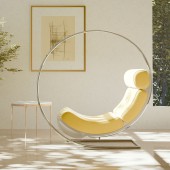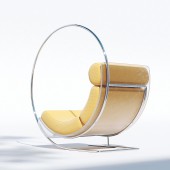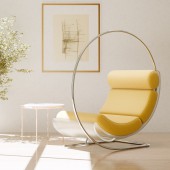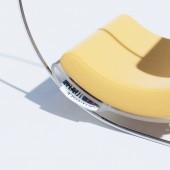Oh Chair Readers' Lounge by Ao Zhou |
Home > Winners > #159602 |
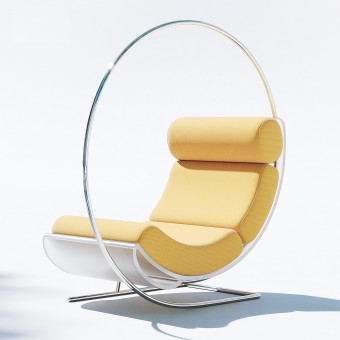 |
|
||||
| DESIGN DETAILS | |||||
| DESIGN NAME: Oh Chair PRIMARY FUNCTION: Readers' Lounge INSPIRATION: The seating of the Oh Chair is reminiscent of bended paper, mimic the lightness and organic fluidity of a paper drifting in the wind, and symbolizing the dawn of a new era. The welded metal tubes, with their simple bends, pay homage to the outline of a classic paperclip. Drawing inspiration from Munich, the birthplace of Stable Diffusion, this armchair seamlessly blends diversity, vitality, humanity, and urban elements all in one. UNIQUE PROPERTIES / PROJECT DESCRIPTION: Oh Chair is a modern response to the iconic retro-futuristic egg chair. By incorporating the bent wire base and the visually open design of the signature seat, the designers were able to capture the essence of their approach to cutting-edge technology. Involving AIGC in the creation process allowed Oh Chair to showcase the designers' perspective on Artificial Intelligence: co-piloting with an open mind and careful consideration, embracing progress while being mindful of the surrounding context. OPERATION / FLOW / INTERACTION: - PROJECT DURATION AND LOCATION: The project started October 2023 in Munich, and finished in January 2024 in Munich and Los Angeles. FITS BEST INTO CATEGORY: Furniture Design |
PRODUCTION / REALIZATION TECHNOLOGY: Design Process: Blender/Figma/Photos SPECIFICATIONS / TECHNICAL PROPERTIES: 706 mm X 1316 mm X 1356 mm TAGS: Artificial Intelligence, Algorithmic Furniture, Retrofuturistic, Sustainability, AI-Assisted Design, Furniture Design, Generative Design, Recycled Material, Stainless Steel, Future Casting, Lounge Chair, Sessel Design, Ergonomics RESEARCH ABSTRACT: This design project is a speculative experience exploring the impact of creative technologies on the design process. We suspect generative design will speed up the early stage exploration with conversational response, but yet know how it helps the final visualization. To figure out, we conducted qualitative research on how the designer workflow is impacted by generative co-creation. In this test, designers are the participants. We collected and analyzed data exchange from every step of the design process, from MidJourney to Blender to Photoshop, and found the preset “prompt” setting of the scope for the entire project. After the back-and-forth chat process between the chief designer and mid-journey, generative tech assisted the designer in putting their vision to work and setting the boundaries and visual direction with an extensive image database from both modernism and retro-futuristic, thus clarifying the designer’s direction with the provided tangible option for the next stage. However, the image generated by AI hardly applies to furniture modeling and production because of its limitation on understanding the z-axis and following the basic law of physics. Here is when the designer takes the lead. During the iteration phase, the design, and design alongside the visualizer collaborated as human factor engineers to restructure the initial design with more human factor and production consideration. Adding human touches, like a round cushion for back support and a visual icon; injects consciousness of sustainability with the material choice. At this stage, generative AI assists the creative process by presenting an incorrect baseline design embodied in the same art direction, this gives designers great motivation to “Correct” the structure, thus self-critique their vision and focus on the human factor and material choices. The result of the research result is that generative AI is a great tool for visualizing designer vision with lightning speed and liberating design from the heavy lifting of self-double by accelerating the brainstorming process with a pre-trained database and creating “other” derivatives from “self” for more conscious iteration and less self double for later revisions. CHALLENGE: Training the AI model is the biggest challenge that we met. Instead of just starting from scratch with a publicly available generative AI model, we trained the Stable Diffusion image-generation model on both modernism and retro-futuristic catalogs from the 1920s-1930s, and 1950s to 1960s. This process leads to thousands of Iterations and Ideations. We need to adapt to the technical demands of AI and invest in training and infrastructure. Images generated with these two distinct data sets reflect the general aesthetic of those time periods and that also correspond with our original design goal: While following the legacy of the timeless design from above two golden periods, exploring new materials, construction techniques, and ergonomic solutions within the constraints of a chair design, ultimately producing a functional and aesthetically compelling piece of furniture. ADDED DATE: 2024-02-27 18:11:29 TEAM MEMBERS (4) : Art Director: Jiaying Zhou(Connie), Chief Designer: Ao Zhou, Visualization Designer: Jackson Zhang and IMAGE CREDITS: Ao Zhou, 2023. |
||||
| Visit the following page to learn more: http://www.mesodesigns.com | |||||
| CLIENT/STUDIO/BRAND DETAILS | |
 |
NAME: Meso Design PROFILE: - |
| AWARD DETAILS | |
 |
Oh Chair Readers' Lounge by Ao Zhou is Winner in Generative, Algorithmic, Parametric and AI-Assisted Design Category, 2023 - 2024.· Press Members: Login or Register to request an exclusive interview with Ao Zhou. · Click here to register inorder to view the profile and other works by Ao Zhou. |
| SOCIAL |
| + Add to Likes / Favorites | Send to My Email | Comment | Testimonials | View Press-Release | Press Kit |

